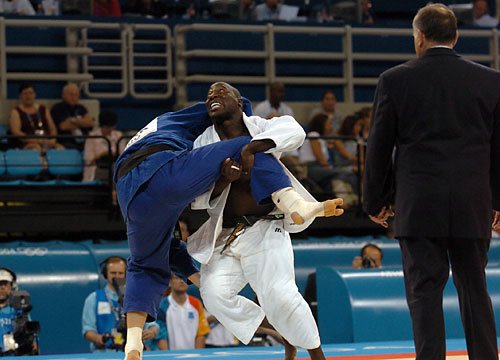I watched what they were working on, and it instantly struck me the inefficient motion I was seeing. They would position themselves for a seio nage shoulder throw. They positioned themselves underneath their opponent, then they used the muscles of their legs to lift the person onto their back. Here they would stay, essentially doing a leg press to push the person away from the Earth. That is a lot of energy being used to throw. A judoka has to push himself up and a resisting opponent all with a few leg muscles with this kind of throw.

Here is an anvil. It represents weight. Imagine it as your weapon. Is it more efficient to drop it on an opponent, or lift it up with him on top?
Here is the deal in throwing arts people, The Earth is our weapon!!! Gravity is the tool. The floor is the target. If you are pushing away from the target, you have a conceptual problem and are doing things inefficiently. Your center is an anvil that you can drop where ever and when ever you want in the conflict.

It seems like many judoka are actually weight lifters. They try to fit in just so they can strain and grunt to lift something away from Earth just to drop it back down again. It works great if you are bigger, and stronger but this path has a dead end. In my humble opinion it violates the principles of the art form. It leads to injuries and strain. It assumes strength is a more important factor in technique than structure, technique and gravity. Weight lifting judo is an immature form a judo.
The high level teachers I have trained with are usually older, weaker and smaller than myself. They all realize one thing - gravity is a constant force pulling them and their opponents down. The softest and most effective judo comes not from lifting weights, but BEING WEIGHT. Why fight against the forces of nature, when effortless energy comes simply from the act of bending our knees, letting our center drop and becoming heavy.
Efficient judo is not lifting weight of a stable structure against gravity.
Efficient judo is loading weight on a opponents crumbling structure at angles that are difficult to recover to. Let your fat butt and gravity do all the work for you. Even one level better - use your opponents fat butt AND your fat butt. That is a lot of free and easy downward pulling energy to exploit without a single pound of lifting force.







Great post. I'm always trying to consider gravity's effect on myself and technique, but because I don't practice judo, this is a brilliant but strange concept for me. To a non-judoka, how could you explain performing a throw without pushing up against someone/gravity if you have to first position yourself under them?
ReplyDeleteThe act of moving under someone's center should be a balance breaking and destabilizing act. The person should be moving around you. Hussey Sensei described it as trading positions with the other person. Imagine the shape of yin yang. This is how things should be moving.
ReplyDeleteDon't know if you're interested, but both Steven Pearlman's The Book of Martial Power and Arakaki's The Secrets of Okinawan Karate: Essence and Techniques have very interesting discussions about the use of gravity power in striking techniques. The former also explores grappling techniques.
ReplyDeleteShoot. Apparently the latter is out of print and used copies command an exorbitant price. Glad I got mine when I did...
Yeah, I had to have the "squatting/lifting" concept taught out of me, too once upon a time. In fact, I heard a story years ago (which means it could be complete rubbish, I suppose, but it makes sense) that some judo players tried an experiment where they fastened lights to different player's centers, then turned out the lights in the room and filmed them doing their tokui waza (favorite technique). To everyone's surprise, the light on their center didn't move down and up, but stayed pretty lateral, moving horizontal to the floor. Basically displacing uke's center, sort of scooping under them, just as you mentioned with the yin and yang.
ReplyDeleteGAP is gravity assisted power. It is a concept from accomplished judoka Danny Da Costa. An interesting principle that he demonstrates in his Shinjido DVD.
ReplyDelete